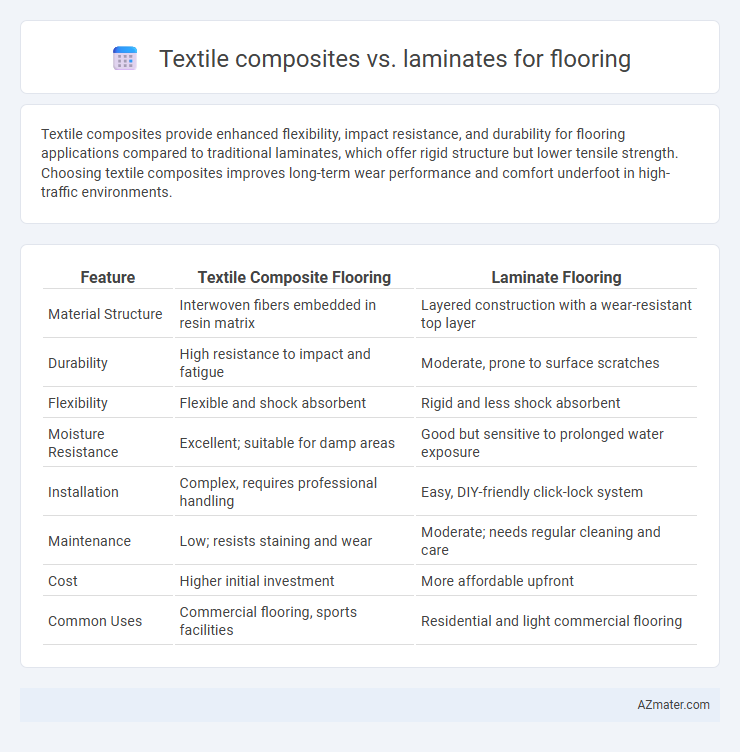Textile composites provide enhanced flexibility, impact resistance, and durability for flooring applications compared to traditional laminates, which offer rigid structure but lower tensile strength. Choosing textile composites improves long-term wear performance and comfort underfoot in high-traffic environments.
Table of Comparison
| Feature | Textile Composite Flooring | Laminate Flooring |
|---|---|---|
| Material Structure | Interwoven fibers embedded in resin matrix | Layered construction with a wear-resistant top layer |
| Durability | High resistance to impact and fatigue | Moderate, prone to surface scratches |
| Flexibility | Flexible and shock absorbent | Rigid and less shock absorbent |
| Moisture Resistance | Excellent; suitable for damp areas | Good but sensitive to prolonged water exposure |
| Installation | Complex, requires professional handling | Easy, DIY-friendly click-lock system |
| Maintenance | Low; resists staining and wear | Moderate; needs regular cleaning and care |
| Cost | Higher initial investment | More affordable upfront |
| Common Uses | Commercial flooring, sports facilities | Residential and light commercial flooring |
Introduction to Flooring Materials
Textile composites and laminates represent advanced flooring materials combining durability and aesthetic appeal through different fabrication techniques. Textile composites integrate reinforcing fibers such as glass or carbon within a resin matrix, enhancing strength and flexibility ideal for high-traffic areas. Laminates consist of multiple layers fused under heat and pressure, offering wear resistance and design versatility suitable for residential and commercial flooring applications.
What Are Textile Composites?
Textile composites are advanced materials made by integrating textile fibers such as carbon, glass, or aramid within a polymer matrix to create a high-strength, lightweight, and flexible structure. In flooring applications, these composites offer enhanced durability, impact resistance, and design versatility compared to traditional laminates composed of layered synthetic or natural materials. Textile composites also provide superior moisture resistance and improved thermal and acoustic insulation, making them a preferred choice for high-performance and sustainable flooring solutions.
Understanding Laminate Flooring
Laminate flooring consists of multiple layers fused together, typically featuring a photographic applique layer that mimics wood or stone, a core layer for stability, and a protective top coat for durability. Compared to textile composites, laminate floors offer superior resistance to scratches, stains, and wear, making them ideal for high-traffic areas. Their easy installation and low maintenance requirements have made laminate a popular choice for both residential and commercial flooring solutions.
Durability Comparison: Textile Composite vs Laminate
Textile composite flooring offers superior durability due to its woven fiber reinforcement, making it resistant to cracking, abrasion, and impact compared to laminate flooring, which relies on a resin-saturated paper overlay prone to surface wear and delamination. The textile composite's inherent flexibility and resilience extend its lifespan, especially in high-traffic or fluctuating humidity environments where laminate often deteriorates faster. Studies show that textile composites maintain structural integrity beyond 10 years under heavy use, whereas laminate floors typically require replacement within 5 to 7 years under similar conditions.
Design and Aesthetic Versatility
Textile composites for flooring offer enhanced design and aesthetic versatility due to their ability to integrate diverse fiber patterns, textures, and colors, allowing for customizable and intricate surface appearances. Laminates, while providing a wide range of printed designs and finishes, often lack the tactile depth and dimensionality of textile composites, resulting in a more uniform and flat visual effect. The structural flexibility of textile composites supports innovative architectural applications and unique design expressions that surpass the traditional laminate aesthetic.
Installation Process and Ease
Textile composite flooring offers a flexible installation process due to its woven backing, allowing easy cutting and fitting around corners and irregular shapes. Laminate flooring typically features a click-lock system requiring precise alignment and additional underlayment, which can increase installation time and complexity. The adaptability of textile composites often results in quicker, more straightforward installations with fewer tools compared to laminate flooring.
Maintenance and Cleaning Requirements
Textile composites for flooring typically require more frequent cleaning due to their porous surface, which can trap dirt and stains, necessitating specialized vacuuming and spot treatments with mild detergents. Laminate flooring offers a smoother, sealed surface that resists moisture and stains, allowing simpler maintenance with regular sweeping and damp mopping using neutral pH cleaners. Both materials benefit from prompt spill removal and avoid abrasive cleaning agents to maintain their durability and appearance.
Comfort and Acoustic Properties
Textile composite flooring offers superior comfort due to its flexible, cushioned structure that absorbs impact and reduces fatigue underfoot, making it ideal for prolonged standing. Its acoustic properties excel by dampening sound transmission and minimizing noise, which enhances the overall indoor environment. In contrast, laminate flooring typically provides a harder surface with less sound absorption and lower comfort levels, often requiring additional underlayment to improve acoustic performance and comfort.
Cost Analysis: Textile Composite vs Laminate
Textile composite flooring generally incurs higher initial costs due to advanced manufacturing processes and specialized material components, whereas laminate flooring offers a more budget-friendly option with mass-produced efficiency. Maintenance expenses for textile composites tend to be lower because of their enhanced durability and resistance to wear, while laminates may require more frequent replacement or repair. Long-term cost analysis favors textile composites for commercial or high-traffic environments, but laminate remains cost-effective for residential use with limited foot traffic.
Sustainability and Environmental Impact
Textile composites for flooring often feature natural fibers like jute or hemp combined with bio-based resins, resulting in lower carbon footprints and enhanced biodegradability compared to traditional laminates. Laminate flooring, typically composed of high-density fiberboard with melamine overlay, relies on synthetic materials and adhesives that can off-gas volatile organic compounds (VOCs), posing a greater environmental impact. Choosing textile composites supports sustainable resource use by incorporating renewable materials and facilitating easier recycling at end-of-life, making them a greener option for eco-conscious flooring solutions.

Infographic: Textile composite vs Laminate for Flooring
 azmater.com
azmater.com